Papers by Gregory Herbert
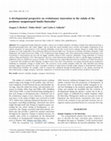
American Malacological Bulletin, 2007
The neogastropod family Muricidae includes a diverse set of radular bauplane, including a beaked,... more The neogastropod family Muricidae includes a diverse set of radular bauplane, including a beaked, three-dimensional form, a flattened-pentacusped form, and a third "dagger" type in which the central rachidian cusp is massive and elongate. Examination of the radular ontogenies of representatives of five muricid subfamilies reveals that several species undergo changes in radular form during ontogeny on a scale comparable to the evolutionary differences between higher taxa. The species Concholepas concholepas (Bruguière, 1789) (Rapaninae) and Trophon geversianus (Pallas, 1774) (Trophoninae) begin ontogeny with a three-dimensional rachidian characteristic of the Ocenebrinae or Muricopsinae but end with the dagger rachidian typical of their respective subfamilies. Young individuals of Vitularia salebrosa (King and Broderip, 1832) (Muricopsinae?) also have a three-dimensional rachidian but shift to a double-dagger morphology by adulthood. Chicoreus (Phyllonotus) pomum (Gmelin, 1791) (Muricinae) has a typical flattened muricine rachidian as an adult but possesses a "buccinoid"-like rachidian just after hatching. Urosalpinx cinerea (Say, 1822) (Ocenebrinae), was unique among the species examined in exhibiting no ontogenetic changes in radular form. The occurrence of two radular bauplane within the same individual snail during ontogeny suggests great potential for rapid, convergent evolution of adult features through simple changes in developmental timing. A three-dimensional rachidian, for example, could be retained into adulthood through paedomorphosis in any lineage possessing the three-dimensional-to-dagger ontogeny. Systematic assignments of muricids based solely on radular features should be reexamined.
Paleobiology, 2004
Understanding ancient and living communities and ecosystems requires intimate knowledge of their ... more Understanding ancient and living communities and ecosystems requires intimate knowledge of their members. We need to know who the members are, how many of them there are, how they interact, and how they collectively forge a workable, durable whole. Not all species ...
Veliger Berkeley, Mar 11, 2008
Paleobiology, 2004
Understanding ancient and living communities and ecosystems requires intimate knowledge of their ... more Understanding ancient and living communities and ecosystems requires intimate knowledge of their members. We need to know who the members are, how many of them there are, how they interact, and how they collectively forge a workable, durable whole. Not all species ...

Journal of archaeological …, Jan 1, 2005
While Olivella beads are a common component of archaeological sites in California, and were widel... more While Olivella beads are a common component of archaeological sites in California, and were widely traded in prehistory, no method has been developed to trace individual beads to a point of origin. This study examines the potential of stable carbon and oxygen isotopes to source Olivella beads from the Pacific coast. The study shows that 1) the oxygen isotopic composition of modern Olivella biplicata shells faithfully varies with ambient sea surface temperature and local upwelling, lending themselves to sourcing studies; 2) oxygen isotope ratios in modern shells can be used to identify shells that grow north versus south of Point Conception, California; and 3) shell carbon isotope ratios may further subdivide these two regions into more spatially restricted source zones. Analyses on a small sample of 10 beads found at various archaeological sites within the interior of California suggest that all were made in southern California.

This study compared the carbon isotopic composition of individual amino acids from muscle tissue ... more This study compared the carbon isotopic composition of individual amino acids from muscle tissue and shell organic matter inclusions in Crassostrea virginica collected along a salinity gradient in the Rookery Bay estuary, Florida. The intent was to assess the extent to which environmental signals relating to spatial and temporal variation in carbon sources were recorded in the amino acids of these materials. There was a trend toward enrichment in δ13C in all amino acids moving seaward along the transect in both organic matter pools, consistent with diminishing influence of terrestrial (C3) production and increased contributions of marine production. The magnitude of this trend was identical for both tissue and shell organic matter, although the values for several constituents of the shell organic matter (aspartic and glutamic acids and glycine) were consistently depleted by approximately 3‰ relative to their equivalents in tissue samples. Other amino acids were directly comparable despite a 2‰ offset in bulk isotopic compositions. Sites were distinguishable from one another in both the tissue and shell organic matter data sets. Although samples were collected across an annual cycle to examine seasonal change, no seasonality was found. The results presented here demonstrate that compound-specific amino acid analysis of carbon isotopes is a useful tool in the analysis and interpretation of biomineral organic materials.
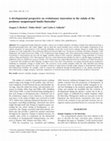
The neogastropod family Muricidae includes a diverse set of radular bauplane, including a beaked,... more The neogastropod family Muricidae includes a diverse set of radular bauplane, including a beaked, three-dimensional form, a flattened-pentacusped form, and a third "dagger" type in which the central rachidian cusp is massive and elongate. Examination of the radular ontogenies of representatives of five muricid subfamilies reveals that several species undergo changes in radular form during ontogeny on a scale comparable to the evolutionary differences between higher taxa. The species Concholepas concholepas (Bruguière, 1789) (Rapaninae) and Trophon geversianus (Pallas, 1774) (Trophoninae) begin ontogeny with a three-dimensional rachidian characteristic of the Ocenebrinae or Muricopsinae but end with the dagger rachidian typical of their respective subfamilies. Young individuals of Vitularia salebrosa (King and Broderip, 1832) (Muricopsinae?) also have a three-dimensional rachidian but shift to a double-dagger morphology by adulthood. Chicoreus (Phyllonotus) pomum (Gmelin, 1791) (Muricinae) has a typical flattened muricine rachidian as an adult but possesses a "buccinoid"-like rachidian just after hatching. Urosalpinx cinerea (Say, 1822) (Ocenebrinae), was unique among the species examined in exhibiting no ontogenetic changes in radular form. The occurrence of two radular bauplane within the same individual snail during ontogeny suggests great potential for rapid, convergent evolution of adult features through simple changes in developmental timing. A three-dimensional rachidian, for example, could be retained into adulthood through paedomorphosis in any lineage possessing the three-dimensional-to-dagger ontogeny. Systematic assignments of muricids based solely on radular features should be reexamined.

Invertebrate Biology, 2014
ABSTRACT Muricid gastropod radulae are more complex than those of most other neogastropods, espec... more ABSTRACT Muricid gastropod radulae are more complex than those of most other neogastropods, especially in the number and variety of cusps, denticles, and interlocking mechanisms. How this complexity evolved, however, is unknown. Morphological gaps between higher taxa within the Muricidae are substantial, and there are few unambiguous intermediates. Here, we use developmental data from the Patagonian trophonine muricid Trophon geversianus to investigate the evolution of an unusual condition in which there are two marginal cusps at each end of each central rachidian tooth, rather than one or none as in most muricids. Trophon geversianus begins ontogeny with one marginal cusp (the inner marginal cusp), but a second (the outer marginal cusp) appears later, arising from separation of the rachidian base edge from the radular membrane rather than through bifurcation or lateral migration of pre-existing cusps. Truncation of development (i.e., paedomorphosis) at this second developmental phase in a trophonine ancestor provides an explanation for the lack of transitional forms between most adult trophonine muricids, which have the plesiomorphic condition of one marginal cusp, and sister group ocenebrine muricids, which have the derived condition of two marginal cusps.

Malacologia, 2015
Radular ontogenies of four species of the neogastropod family Muricidae are described through com... more Radular ontogenies of four species of the neogastropod family Muricidae are described through comparisons of early post-metamorphic and adult developmental stages, with specific focus on the rachidian (central) tooth. The degree of rachidian transformation during ontogeny varies from minor shape change to addition or loss of structural features important for assigning taxa to subfamilies. Changes include: flattening of the rachidian base and a switch from a short, beak-like to a long, flattened central cusp in the rapanine Stramonita biserialis; a switch from variable, asymmetric to regular, symmetric expression of inner lateral denticles in the basal muricid Timbellus phyllopterus; curvature of the rachidian base at the margins and separation of the pointed base endpoint from the radular membrane to form a marginal cusp in the muricine Chicoreus dilectus; and moderate straightening of the rachidian base in the ocenebrine Vokesinotus perrugatus. From these observations and previous work, we propose a plesiomorphic developmental sequence for the Muricidae and provide supporting evidence for the developmental origins of novel features of the muricid radula.
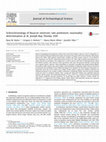
Recent archaeological investigations indicate that coastal Fort Walton cultures in the St. Joseph... more Recent archaeological investigations indicate that coastal Fort Walton cultures in the St. Joseph Bay region of northwest Florida emphasized marine and estuarine foraging. These late prehistoric, Mississippiperiod (A.D. 1000e1500) peoples collected fish, shellfish, and other aquatic resources. At the Richardson's Hammock site (8Gu10), radiocarbon-dated to about A.D. 1300, large, predatory gastropods were a major subsistence component. This adaptation is in sharp contrast with that of contemporaneous inland Fort Walton societies, who relied on maize agriculture, and raises the question whether coastal groups were separate hunteregathererefisher populations or migrated seasonally from inland farming villages. We perform stable oxygen and carbon isotope sclerochronology on lightning whelks (Busycon sinistrum) to determine the seasonality of Fort Walton foraging and to compare the environment of prehistoric St. Joseph Bay with that of the modern bay. Oxygen isotope profiles suggest that shellfish collecting was relegated primarily to the summer months, producing a scheduling conflict with the primary growing season for maize in northwest Florida. Thus, coastal and inland Fort Walton sites probably represent separate culture groups. The relationship between d 18 O shell and d 13 C shell indicates similar environmental and climatic conditions between prehistoric St. Joseph Bay and today. However, modern whelks are depleted in 13 C compared to Fort Walton whelks, which reflects both twentieth century CO 2 emissions and years of dredging and wastewater pollution entering the bay.
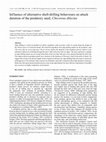
Edge drilling is a form of predation in which a predatory snail excavates a hole at a point along... more Edge drilling is a form of predation in which a predatory snail excavates a hole at a point along the margin of the closed valves of a bivalved animal. We tested the hypothesis that edge-drilling attacks by the predatory snail Chicoreus dilectus on its clam prey Chione elevata shorten the duration of the predation process relative to the alternative behaviour of drilling through the prey's shell wall away from its edges. The time required to complete an edge-drilling attack was on average about three times less than when prey were attacked through the shell wall. This improvement in predation speed was a function of the thickness of the prey's shell at the point of attack. We suggest that owing to the shorter length of time required to kill prey, the edge-drilling behaviour may be selectively advantageous in environments where enemies are abundant, especially competitors that might attempt to steal prey. Behaviours that speed up the predation process may create opportunities for more effective exploitation of available prey resources in highly competitive environments.
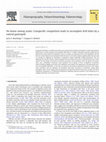
Incomplete drill holes in shelled invertebrate prey produced by predatory gastropods are often in... more Incomplete drill holes in shelled invertebrate prey produced by predatory gastropods are often interpreted as failed attacks, and the frequency of incomplete drill holes in a sample is thought to provide insight into the effectiveness of prey defensive adaptations. Here, we conduct an experimental test of the hypothesis that differences in the frequencies of incomplete drill holes do not necessarily indicate anything about the prey and can instead be triggered by disturbance competition among conspecific drilling gastropods. Our test employed the western Atlantic naticid gastropod Neverita delessertiana and its venerid bivalve prey Chione elevata. The experiment consisted of an isolation treatment, where predators fed in the absence of conspecifics, and a competition treatment, where predators fed in groups of three. Competitive interactions, which included grappling, prey theft, and cannibalism, were found to be important in determining the presence of incomplete drill holes, as this trace was absent in the isolation treatment but present in the competition treatment, with the frequency of incomplete drill holes increasing in interactions among larger gastropods. These results suggest that interpretations of both field and fossil data must consider the role of competitive disruption as an additional mechanism underlying long-term patterns in the frequency of incomplete drill holes in the fossil record.
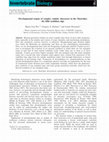
Muricid gastropod radulae are more complex than those of most other neogastropods, especially in ... more Muricid gastropod radulae are more complex than those of most other neogastropods, especially in the number and variety of cusps, denticles, and interlocking mechanisms. How this complexity evolved, however, is unknown. Morphological gaps between higher taxa within the Muricidae are substantial, and there are few unambiguous intermediates. Here, we use developmental data from the Patagonian trophonine muricid Trophon geversianus to investigate the evolution of an unusual condition in which there are two marginal cusps at each end of each central rachidian tooth, rather than one or none as in most muricids. Trophon geversianus begins ontogeny with one marginal cusp (the inner marginal cusp), but a second (the outer marginal cusp) appears later, arising from separation of the rachidian base edge from the radular membrane rather than through bifurcation or lateral migration of pre-existing cusps. Truncation of development (i.e., paedomorphosis) at this second developmental phase in a trophonine ancestor provides an explanation for the lack of transitional forms between most adult trophonine muricids, which have the plesiomorphic condition of one marginal cusp, and sister group ocenebrine muricids, which have the derived condition of two marginal cusps.
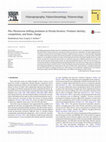
Identifying gastropod predators from the morphology of their drill hole traces is an important st... more Identifying gastropod predators from the morphology of their drill hole traces is an important step in testing the disruptive effects of prey evolution on the prey size selectivity behaviors of predators. For bulk sampled bivalves of the genus Chione from the late Neogene of Florida, temporal patterns of prey size selectivity differ depending on whether drill holes from naticid and muricid gastropods are lumped together or separated. When drill hole producers are identified to family level using revised experimental criteria developed specifically for this study system, we find that naticid and muricid prey size selectivity responds in different directions and at different times, but both groups exhibit change in prey size selectivity beginning around 2.5 Ma. We reject previous conclusions that changes in drilling gastropod prey handling behaviors were driven by changes in prey morphology associated with a species turnover event at 1.8 Ma. Prey density, threats from enemies, and habitat structure were also changing throughout the study interval, but none of these factors alone provides a complete explanation for observed changes in predator behaviors for either family. We conclude that multiple factors drive predator behavioral change, and that different predator types have different sensitivities to these factors.






Uploads
Papers by Gregory Herbert